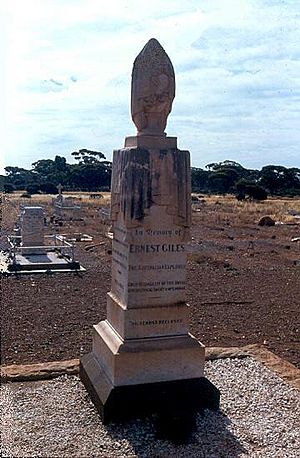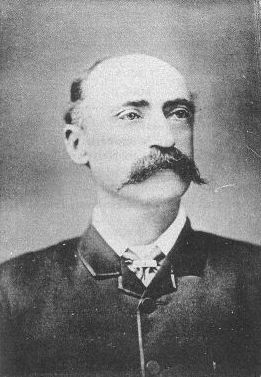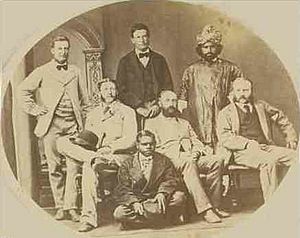Ernest Giles facts for kids
William Ernest Powell Giles (born 20 July 1835 – died 13 November 1897), known as Ernest Giles, was an Australian explorer. He led five big trips into the unknown parts of South Australia and Western Australia.
Contents
Early Life
Ernest Giles was born in Bristol, England. His parents were William Giles and Jane Elizabeth Giles. When Ernest was 15, in 1850, he moved to Australia to join his parents in Adelaide.
In 1852, Giles went to the goldfields in Victoria. Later, he worked as a clerk in Melbourne. But he soon got tired of city life. He moved to the countryside and learned important skills for living in the Australian bush. In 1865, he explored areas north-west of the Darling River. He was looking for good land for farming and for growing hemp, which was used to make rope.
First Big Journey
Ernest Giles didn't lead a big, planned trip until 1872. With two other men, he left Chambers Pillar in the Northern Territory on August 22. They traveled through a lot of land that no one had mapped before, heading north-west and west.
They found their path blocked by Lake Amadeus, and their horses were getting very weak. So, they had to turn back. They returned to the Finke River and then to Charlotte Waters, arriving in Adelaide in January 1873. Giles felt this trip was a failure. But he did well, considering how small his group was and what little equipment they had.
Second Journey
Giles' friend, Baron von Mueller, helped raise money for a new trip. William Tietkens joined as the main helper, and with two other men, they started on August 4, 1873. This journey began further south than the last one. From the Alberga River, they mostly headed west.
A month later, in the Musgrave Ranges, they found a river and named it the Ferdinand. By October 3, 1873, they were near longitude 128 East. The land was extremely dry. It was a constant struggle to find enough water for the horses.
In early November, they had passed longitude 126. They decided to turn back a bit, and on December 20, 1873, they reached the area of Mount Scott. They then turned north and west again. Their furthest point west was reached on April 23, 1874.
Giles and one of the men, Alfred Gibson, were scouting ahead when Gibson's horse died. Giles gave Gibson his own horse and told him to follow their tracks back to get help. Giles walked back to their camp in eight days, almost completely exhausted. He found that Gibson had not arrived. They searched for Gibson for several days but couldn't find him. Their supplies were almost gone, so they had to give up. On May 21, 1874, they began the return journey. Giles named the desert the Gibson Desert after his lost friend. On June 24, 1874, they were on a good path to the Finke River, and on July 13, 1874, they reached Charlotte Waters. Giles had still not crossed the continent, but he had done everything possible in the difficult conditions.
Giles was the first European to see the rock formations now known as Kata Tjuta/Mount Olga, and Lake Amadeus. He wanted to name them after his helper, Baron Ferdinand von Mueller. However, Mueller convinced him to name them after King Amadeus of Spain and Queen Olga of Württemberg. Giles also supposedly discovered Uluru, but another explorer, William Gosse, claimed it first.
Third, Fourth, and Fifth Journeys
In early 1875, Giles got his travel notes ready to be published. On March 13, 1875, with help from Sir Thomas Elder, he started his third journey. He went far north from Fowler's Bay, but the land was very dry. Giles turned back, then went east, and finally around the north side of Lake Torrens to Elder's station at Beltana.
At Beltana, he got ready for his fourth journey. With Tietkens again as his second-in-command, and a group of camels, they started on May 6. An Afghan cameleer named Mahomet Saleh, who had traveled with explorer Peter Warburton before, managed the camels. They reached Port Augusta on May 23. After going north to avoid the lakes, they mostly headed west. They carried some water, which saved them from constantly searching for water for horses, a problem on earlier trips.
Towards the end of September, they had traveled over 323 miles (520 km) in 17 days without finding water. On September 25, one of the Aboriginal guides, Tommy Oldham, found plenty of water in a small hollow between sand dunes. Giles named this place Queen Victoria Spring, and the group was saved. After resting for nine days, they continued west on October 6. Ten days later, a large group of Aboriginal people attacked the expedition, and Giles fired at them. On November 4, they met a white stockman at Tootra out-camp, east of Bindi Bindi, Western Australia. They continued west to Walebing Station, then south-west. On November 11, they arrived at New Norcia and were welcomed by Bishop Salvado. On November 17, 1875, the group arrived at Guildford, and then Perth the next day, where they received a very warm welcome.
Giles stayed in Perth for two months. Tietkens and Jess Young, another member of the trip, went back to Adelaide by sea. On January 13, 1876, Giles began his return journey (his fifth trip). He took a path about 400 miles (640 km) north of his last journey. They arrived in Adelaide in September 1876. It was a good journey, and the camels proved to be very helpful.
Later Life and What He Left Behind

From 1877 to 1879, Giles worked classifying land in Victoria.
In 1880, he published a book called The Journal of a Forgotten Expedition, which told the story of his second and third journeys. Then, in 1889, he released Australia Twice Traversed: The Romance of Exploration in two large books. This book covered all five of his expeditions.
He made a few other smaller trips. His last years were spent working as a clerk in an office in Coolgardie. Here, his great knowledge of the Australian interior was always useful for gold prospectors.
Giles received important awards for his work. He became a fellow and was given the Patron's Medal by the Royal Geographical Society in 1880. He was also made a Knight of the Order of the Crown of Italy by King Vittorio Emanuele II.
Even with all his explorations, the Australian governments at the time did not give him much financial reward.
Ernest Giles died from pneumonia in Coolgardie on November 13, 1897. He was buried at the Coolgardie Cemetery. He was not married.
In 1976, he was honored on a postage stamp in Australia that showed his picture.
Several places are named after him, including Mount Giles, which is the third highest mountain in the Northern Territory. There is also Lake Giles, about 100 miles (160 km) north of Southern Cross, Western Australia, and the Giles Weather Station, near the border of Western Australia and South Australia.
Family
- William Giles (c. 1795 – 1860) and Jane Elizabeth Giles (c. 1804 – 1879) were Ernest's parents.
- Ernest Giles (1835 – 1897) was the subject of this article.
- His eldest sister, Jane Rebecca Giles, married George Duff Gill. Ernest Giles named the George Gill Range after him in 1872.
- Ernest Giles was not related to another explorer named Alfred Giles, but they knew each other through their work.
Images for kids
See also
- Exploration of Australia








